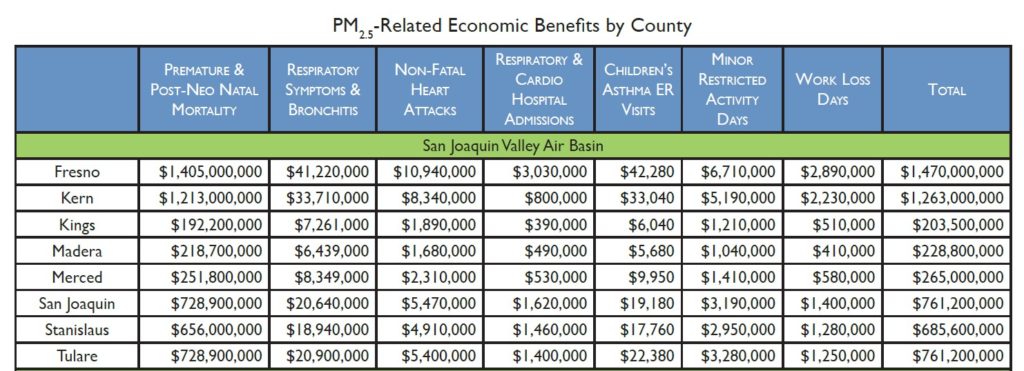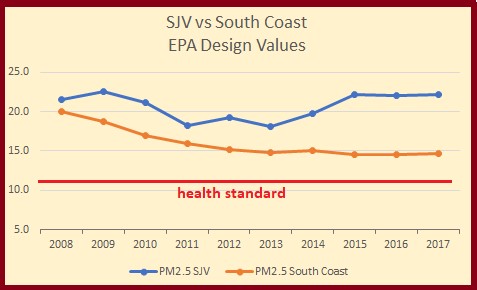
By Tom Frantz
It is a fact that residents in Fresno, Tulare, Kings and Kern counties breathe the worst air in the nation. The rest of the San Joaquin Valley is slightly better. This pollution affects the health of everyone in negative ways and leads to high rates of disease, premature birth and premature death.
We have the worst ozone levels in the summer and the worst particulate (PM2.5) levels in the winter. Toxic air contaminants from oil production and agricultural pesticides also add to local health issues.
The cost of not meeting current Clean Air Act standards for PM2.5 is more than $1 billion in Kern County, nearly $1.5 billion in Fresno County and nearly $6 billion for the San Joaquin Valley. It is definitely PM2.5 pollution that causes the most damage. Improvements have been slow and seem to have disappeared over the past decade.
From the profound 2008 economic study by Jane V. Hall, Ph.D., Cal State Fullerton, entitled “The Benefits of Meeting Federal Clean Air Standards in the South Coast and San Joaquin Valley Air Basins,” the chart below shows how the $6 billion benefit would impact the various counties of the valley.

How has our air quality fared since this study in 2008? Here is the official PM2.5 Design Value trend for the San Joaquin Valley as calculated by EPA.

This data clearly show the San Joaquin Valley with the worst levels in the nation since 2008. The health costs have only gone up since the Jane Hall study. The population has grown 5%, so more people are exposed and medical care inflation costs have done their job.
A quick graph of the Environmental Protection Agency (EPA) data for the San Joaquin Valley shows that improvement in PM2.5 levels has been elusive for the past 10 years. The current health standard is the red line at 12 micrograms per cubic meter. Other areas, such as the LA Basin, have shown significant improvement over this same period.

There should be great local concern about recent efforts by members of Congress to weaken the Clean Air Act and current efforts by the Trump administration to weaken national air quality standards.
In 2017, local Congressional Reps. Kevin McCarthy (R–Bakersfield), David Valadao (R–Hanford) and Jim Costa (D–Fresno) were sponsors of HR 806 at the request of the San Joaquin Valley Air Pollution Control District.
Under the false guise of “modernizing” the Clean Air Act, this bill, written by leadership at our air district, actually would have weakened the protections contained in the act. It would have taken away sanctions on big polluters for failure to meet national air quality standards on time, weakened the requirements for meeting those standards and actually delayed the deadlines for the most recently established health-based standards. HR 806 passed the House but fortunately died in the Senate.
Now, with the Trump administration and the Pruitt-Wheeler–led EPA, the manner in which health standards are set is being challenged with the real possibility that some standards will be weakened.
The EPA has the duty to periodically review each health standard relating to air quality by looking at the latest and best science. They are to set lower, more health-protective standards when the science indicates it as necessary. They are not to look at economic factors when setting these standards. Standards have periodically been lowered as science has discovered more and more negative health effects from exposure to polluted air.
The seven-member Clean Air Scientific Advisory Committee (CASAC) reviews these standards for the EPA. Helping them was a 20-member Particulate Matter Review Panel just for reviewing PM2.5 standards. That subcommittee was recently disbanded leaving the intensive scientific scrutiny of relevant studies to seven recently appointed people, many with strong ties to industry instead of doctors and scientists as in the past.
At a meeting in March, CASAC Chair Tony Cox and member Steven Packham openly expressed doubts about the validity of long-held conclusions linking PM2.5 to premature death. Like climate deniers, they are sowing doubt about well-established scientific fact and thereby putting a monkey wrench into the process of reviewing new science and the chance of any tightening of health standards. By questioning the old science, they are also questioning the validity of the current standards that could lead to less pressure on areas such as the San Joaquin Valley to meet those standards.
We need our current representatives in Congress to ensure that the EPA properly performs its duties to protect the health of local residents from unhealthy levels of air pollution. Recent changes and processes at the EPA regarding the review of air quality health standards needs to be monitored closely. Congress must insist that there be no backsliding or weakening of current standards and that new standards are implemented based on the preponderance of evidence developed by the scientific community-at-large.
*****
Longtime clean air advocate Tom Frantz is a retired math teacher and Kern County almond farmer. A founding member of the Central Valley Air Quality Coalition (CVAQ), he serves on its steering committee and as president of the Association of Irritated Residents. The CVAQ is a partnership of more than 70 community, medical, public health and environmental justice organizations representing thousands of residents in the San Joaquin Valley unified in their commitment to improving the health of Californians. For more information, visit www.calcleanair.org.
